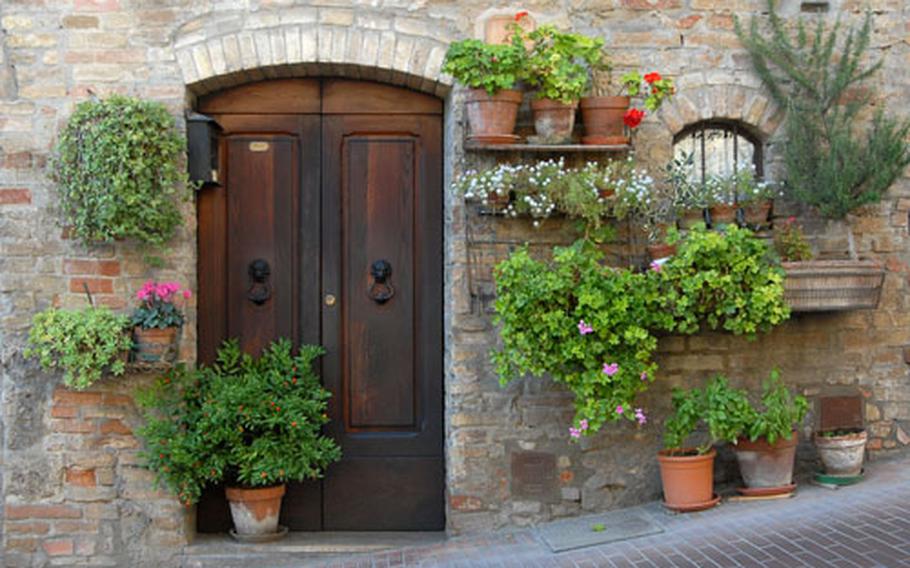
There is not much green in San Gimignano with its brick walls and cobblestone streets, but its citizens do a good job beautifying the town. See our for more images of San Gimignano. (Michael Abrams / S&S)
Sitting on a hilltop, surrounded by vineyards, the town can be seen from miles away.
It is called the “city of beautiful towers” or “Medieval Manhattan” — both fitting names for San Gimignano, Italy, an old walled town in central Tuscany.
While the site can trace its development from a small Etruscan settlement in the second-century B.C., the history of the present San Gimignano begins in about the 10th century.
Named after a fourth-century Modena bishop, the town has seen its fortunes ebb and flow through the ages. It suffered through the plague; the rivalry of two great medieval factions, the Guelfs and the Ghibellines; and the upheaval from its support of Florence during its wars with Siena, Pisa and others. Throughout the centuries, its fortunes declined — there were once 72 medieval towers; only 14 remain — until the start of the tourist invasion in the last century.
San Gimignano, with its towers, walls and cobblestone lanes, could be the most romantic of towns, if it were not for the visiting hordes.
From the crack of dawn until late afternoon, the city is in tourists’ hands. Day-trippers from Florence and Siena occupy the restaurants, cafes and shops and clog the town’s museums and sights.
But one can’t really blame them for coming. There is plenty to see in this fascinating city.
First, the towers: They were built as both private fortresses and as a show of the owners’ wealth. Trying to outdo one another, the builders built them taller and taller. Even the few that remain are a mesmerizing sight, whether seen from afar or close up in the town they dominate.
San Gimignano’s two squares, Piazza della Cisterna and Piazza del Duomo, are the heart and soul of the town. Della Cisterna gets its name from the well at its center. Here, besides the cafes, there are two ice cream parlors selling gelato. One’s claim to fame is that it was a member of the 2006 Gelato World Championship team. Both serve delicious ice cream. A sunny day will have tourists sitting on the well, licking their ice cream cones.
The Piazza del Duomo features many of the city’s important buildings — the cathedral it is named for, the town hall and the 178-foot-tall Torre Grossa.
A ticket to the Civic Museum with its art gallery lets you climb the Torre Grossa, which offers a great view over the town and across the countryside.
The exterior of the 12th-century cathedral, the Basilica of Santa Maria Assunta, is nothing fancy, but inside is another matter. Its walls are covered by frescoes ]by the Sienese School from the 13th to 15th centuries. Along the south wall, they depict the life of Christ, along the north, the Old Testament. There are also frescoes of the Last Judgment and a chapel to Santa Fina, a local saint.
In a building next door is the Museum of Sacred Arts. Other San Gimignano museums are dedicated to archaeology, ornithology, torture and wine.
Wine plays a major role in San Gimignano. Red wine is big in Tuscany, of course, but here a white, Vernaccia di San Gimignano, is the big player. You can buy it and other wines from the region at the stores that line the town’s two main streets, Via San Giovanni and Via San Matteo.
Shopping is big here, too. A stroll will take you past shops selling Tuscan specialties such as boar sausage and ham, cheese, linens, ceramics, art and more wine. A market comes to town on Thursday mornings, featuring most of the above, plus household goods, clothes and shoes, and adding to the crowds.
It is possible to escape the hustle and bustle. For example, the Rocca, a 14th-century fortress, is in town but just far enough off the beaten path to offer a little quiet.
For a nice walk, there’s a path that leads all the way around town, on the outside of the city walls. Despite varied views of the town and a splendid view of the Tuscan countryside, nary a tourist is to be seen.
Another option is to buy some bread, cheese, sausage and wine at a shop. Then hike into vineyards for a picnic with a panorama of the town and towers.
But to really appreciate the place, wait until the tour buses leave …
Then the locals and the tourists staying for the night have San Gimignano to themselves.
To join them, first have a drink at a cafe on the Piazza della Cisterna. Follow with a romantic dinner at one of the restaurants featuring Tuscan cuisine, then a post-meal stroll along the town’s ancient streets.
That’s how to truly enjoy San Gimignano, Italy’s città delle belle torri.
Know and Go
Getting there: San Gimignano is in the Tuscany region of Italy, about halfway between Florence and Siena. Coming from either city, exit the four- lane highway that connects the two at Poggibonsi Nord, and follow the signs to San Gimignano. Coming from Livorno or Pisa, take the Florence-Pisa- Livorno dual carriageway toward Florence, exiting at Empoli Ovest. Follow signs for Castel-fiorentio and Certaldo. At Certaldo, follow signs to San Gimignano.
Note: Cars are not allowed inside the city walls, and parking outside of them at 2 euros per hour is expensive.
Information: The tourist information center is in the Palazzo Communale (city hall). Here you can get maps, brochures and rent audioguides.
The city’s Web site is www.sangimignano.com.
— Michael Abrams